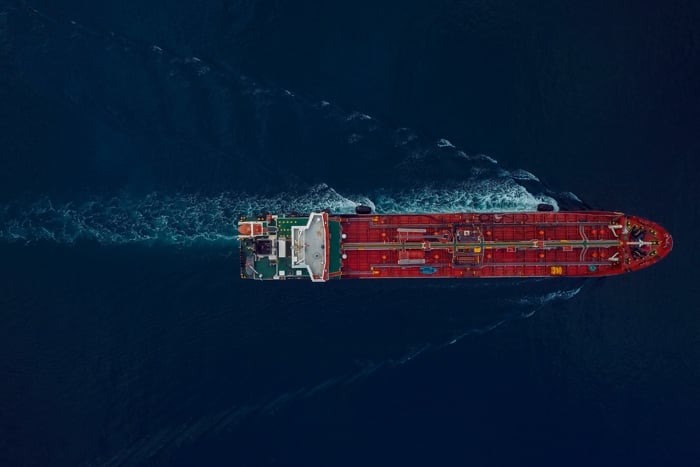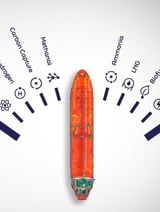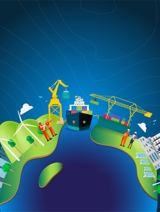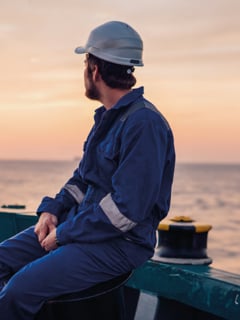Pioneering projects relating to the global fuel transition now hit the press most days and Panos Mitrou, LR’s Global Gas Segment Manager, fears that some people have lost sight of the big picture. “It’s a matter of perspective,” he told Horizons. “Of course, it’s fantastic to have e-hydrogen and biogas as likely components in tomorrow’s energy mix. But let’s not lose sight of the here and now. There are many millions of people who don’t even have access to gas yet – they still rely on firewood, cow dung, coal and charcoal for cooking… every day.”
This point was highlighted at a recent meeting of the African Refiners and Distribution Association, when it came to light that 850 million Africans still depend on solid fuels for cooking, and as many as 600,000 die each year from household air pollution. Organisations attending the meeting, including the World LPG Association, the Global LPG partnership, the Shell Foundation and Oryx Energies, agreed on the urgency of establishing an efficient LPG supply chain in Africa as an absolute priority. Mitrou revealed LR’s renewed commitment to the LPG sector, whereby the class society already ranks number one in the marine field. Although it is still a hydrocarbon, ocean LPG trades are developing rapidly, notably on longer routes requiring larger vessels. These developments have been the driver for LR to take up membership of the World LPG Association recently, he said. He applauds the fantastic initiatives in northern Europe, the US and parts of Asia in the field of low- and zero-carbon fuels – ammonia, hydrogen, power cells, biogas and e-LNG, for example. But he is also under no illusion that any of these fuels will meet a substantial share of the world’s energy needs any time this decade. Vital stepping-stone
“As the only classification society member of the WLPGA, we are keen to represent the assurance sector and monitor the latest developments – commercial and technical – in the seaborne transport of LPG. The fuel is important for several reasons. One, it is far more climate-friendly than biomass – wood, dung or coal. Two, it is relatively easy to transport and store. Three, LPG could transform the lives of many millions of people. And four, like LNG, LPG could pave the way for the new low- or zero-carbon fuels of the future.”
WLPGA We have to be there
“As the top class society in LPG, we have to be there,” declared Mitrou, LR’s Global Gas Segment Manager, as he explained the company’s recent move to join the World LPG Association (WLPGA). As the sector’s expansion accelerates, the WLPGA will play a pivotal role as a forum for major charterers and owners to discuss the future. Mitrou highlighted recent initiatives by major charterers in the sector. Singapore-based Trafigura, for example, is one of shipping’s largest customers in various sectors, including LPG. The multinational is also a member of the WLPGA and has been one of the most vocal of shipping’s customers in the pursuit and support of sustainability initiatives recently. Over recent months, the company has fixed a growing number of LPG tankers – both medium-sizes and very large units – designed to use LPG as fuel. Earlier this year, Trafigura took a minority stake in Bboxx, a company that intends to offer energy consumers in Africa a pay-as-you-go (PAYG) system to use LPG as energy. Bboxx has already introduced such a system to provide solar power to African households which still use wood or charcoal for cooking. The use of biomass for fuel can cause to sickness, millions of premature deaths, deforestation, black soot and emissions. Trafigura is also a member of the Sea Cargo Charter, a move by shipping’s customers to raise ESG principles in the chartering of ships. Earlier this year, the company submitted proposals for a carbon levy to the IMO. This would encourage shipowners to use fuels with a lower carbon content than heavy fuel oils, either with scrubbers or in low-sulphur form.
Vital stepping-stone …
Hydrocarbon gases – LPG as well as LNG – have an important role to play in the global decarbonisation process, Mitrou stated. “And could be the stepping-stone in hastening the transition from hydrocarbons – coal, in particular – in many parts of the world, Europe included.” On the LNG front, the number of floating storage and regasification projects continues to grow, Mitrou said, pointing to new ones across southern Europe – in Greece, Croatia and Cyprus. India’s first floating storage regasification unit (FSRU), Höegh Giant, has just started operating in Maharashtra State. It is the first of many FSRUs that are planned around the vast Indian coastline. The Indian Government aims to increase LNG’s share in the country’s energy needs from 6% today to 15% by 2030. However, although most of the gas focus recently has been on LNG, both as an energy source and a marine fuel, Mitrou is pleased to have noted an upturn in LPG-related projects. He said that LPG – most commonly propane and butane – is often seen, unfairly, as “LNG’s poor relation”. But LPG has many of the same benefits, with a few more thrown in besides. For example, since LPG is not cryogenic, it can be handled, stored and transported much more easily. The fuel does not require the same level of capital expenditure in assets, either ashore or afloat, and setting up supply chains is far simpler.
… but not a long-term option
However, Mitrou readily conceded that neither LPG or LNG offers a long-term option. But they do provide transition fuels to aid and hasten the global decarbonisation process. This must be tackled universally, he insisted, not just in rich countries which can afford to pioneer the expensive R&D projects that most other countries can’t. Neither LNG nor LPG is carbon-free, and their combustion generates other harmful emissions too. However, both are far less emissions-intensive than other hydrocarbon fuels, including fuel oil, diesel and kerosene, and many times better than coal or firewood. In the world’s poorest regions where fuel availability is limited, there is still a huge dependency on biomass as a source of energy – notably coal, charcoal and firewood. The fuels are often used in primitive dwellings without proper ventilation. Respiratory diseases are a frequent and inevitable outcome, Mitrou said, and often a killer. For these people, he declared, e-LNG, ammonia and hydrogen fuel cells are light-years away.

"[Hydrocarbon gases] could be the stepping-stone in hastening the transition from hydrocarbons – coal, in particular – in many parts of the world, Europe included."

Roller coaster ride for VLGC owners.
The last 12 months have been more unpredictable than usual for Very Large Gas Carrier (VLGC) owners. From rates which had originally plunged to below $20,000 a day on some key routes in mid-2020, they shot up to more than $100,000 from the Middle East to Japan by the end of the year. During the second half of May 2021, Clarkson Research estimated typical LPG one-year timecharter rates at about $40,000. The LPG trades have remained mostly buoyant because Asian demand has held firm, brokers say. Industrial uses include steady demand from propane dehydrogenation (PDH) plants. These produce propylene, much of which ends up as plastic. This demand, therefore, is relatively inelastic. There is, of course, a wide network of trades but VLGC demand is driven principally by two main trade lanes – US to Asia, and Middle East to Asia. Large vessels dominate on both routes, but US export trades generate greater tonne-mile demand due to voyage length. LPG in the US is often a result of the LNG production process, rather than oil refining as it is in the Middle East. Therefore, US output of propane and butane, key LPG gases, has been less affected by the pandemic. Middle East exporters, on the other hand, have wrestled with output constraints as they faced the oil price crash of 2020. But there are other factors at work too. Brokers point out that an influx of new VLGCs in 2015-16 has resulted in a flurry of five-year special surveys, taking sizeable chunks of tonnage out of the system during spells over the last 12 months. Meanwhile, congestion at the Panama Canal has caused additional supply disruption, with some owners sending ships from the US Gulf to Asia via the Cape of Good hope, reducing tonnage supply still further. The orderbook has a telling story. More than half of LPG carriers currently on order – 60 out of 116, according to Clarkson Research – are VLGCs. Ships on order account for 21% of the existing fleet, and 52 of them will be powered by ‘alternative fuels’, Clarkson says, which in this case means LPG. This confirms Panos Mitrou’s belief that LPG owners expect significant growth in LPG on longer routes. A new trade from the US to India is gaining ground and experts suggest that it is only a matter of time until VLGCs are deployed on trans-Atlantic routes between the US Gulf and Africa.
Behind the curve
However, it is not only remote communities in Africa, India and Indonesia, for example, that lag behind the high-profile initiatives involving hydrogen power cells and green electricity from the wind and sun. Many countries in the so-called developed world are a long way behind the energy transition curve, mostly because they have other priorities including the availability of food and universal healthcare. “The EU is one of the most advanced parts of the world in terms of energy transition,” Mitrou observed, “and the development of new fuels is essential. But we must be realistic too. I believe that it is inevitable that Europe will still be using more gas at the end of this decade than it was in 2020. “There are large regions in the east of the continent that are still heavily reliant on coal. Moving those countries to gas would yield major carbon emission reductions.” But Mitrou sees the greatest potential in the world’s poorest continent where a scarcity of resources – water, energy, food – still constrain the lives of many. “There is a long energy pathway between here and 2050,” he said in conclusion. “We must not leave any stone unturned along the way and LPG could have a vital role
"I believe that it is inevitable that Europe will still be using more gas at the end of this decade than it was in 2020."
LPG as a marine fuel
Many LPG are designed to burn part of their cargo as fuel. This boosts ship efficiency by saving time on bunkering and simplifying fuel systems on board ship. However, the demands of cargo receivers are having an impact on LPG tanker design, according to Mitrou, LR’s Global Gas Segment Manager. Over the last ten years or so, many very large gas carriers (VLGCs) have drawn down a small volume of LPG to provide bunker fuel for a voyage. However, receivers are now more specific about the volume of a delivered consignment. As a result, large vessel designs have been adapted to provide a little more capacity than required for a typical cargo stem of 84-86,000 cubic metres, a standard volume on the long trade lanes between the US or Middle East, for example, and Asia. Receivers of smaller LPG cargoes are also more likely to demand a certain delivered volume, Mitrou explained. Some older vessels, which also use LPG as fuel, cannot always fulfil this requirement and are, therefore, sometimes at a commercial disadvantage. LR has been engaged in the design assurance of a range of new LPG tankers in the smaller sizes which incorporate LPG fuel tanks on deck. Mitrou acknowledged that this adds to the initial cost, but experience indicates that this additional up-front investment soon pays back. Meanwhile, some engine builders have introduced LPG-fuelled engines for other ship types. The fuel offers immediate benefits including lower emissions of CO2, SOx and NOx although this depends, to some extent, on engine design. However, unlike LNG, there is no risk of methane slip. Emissions of black carbon and particulates are virtually eliminated. Overall greenhouse gas emission savings are estimated








